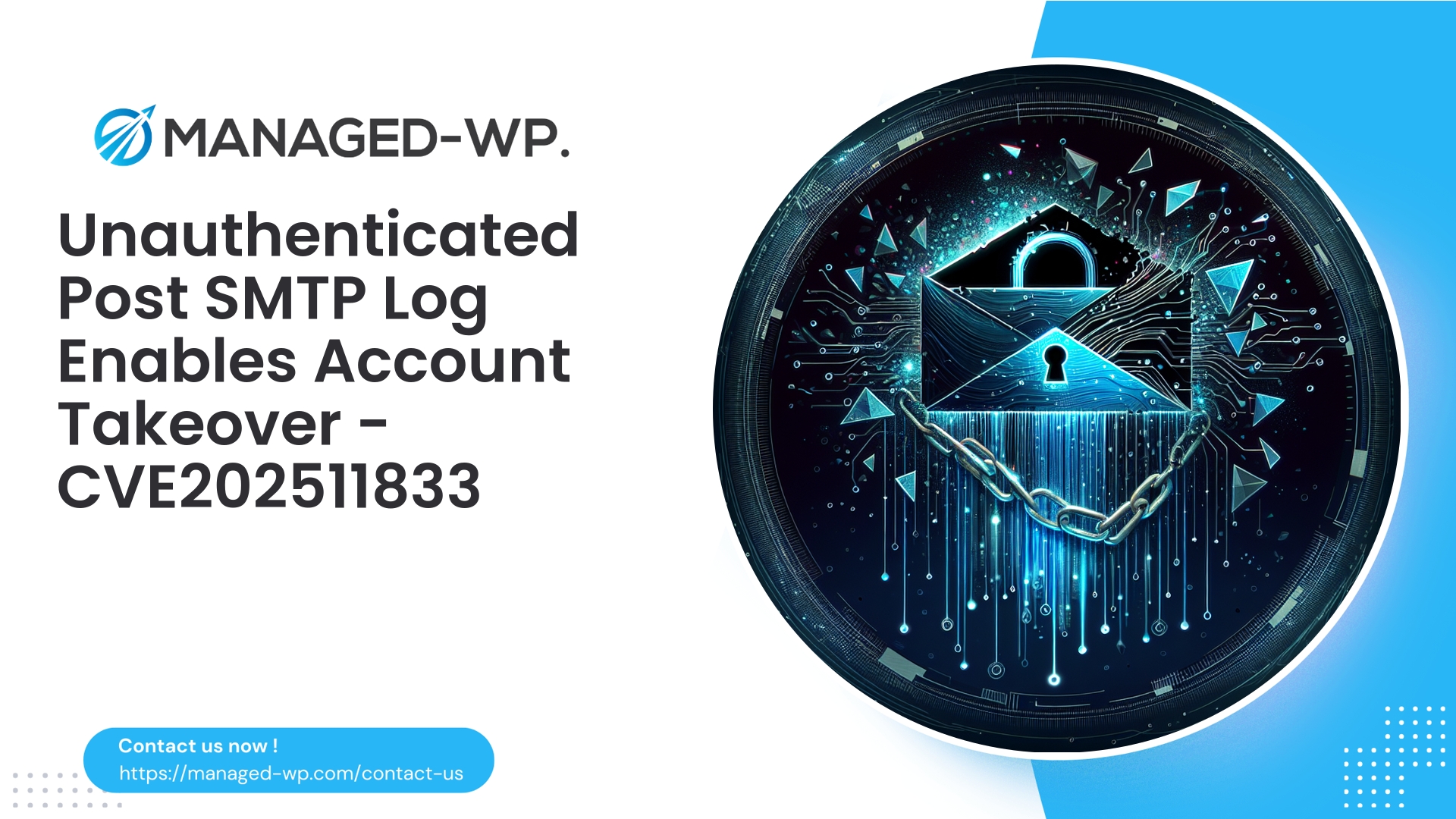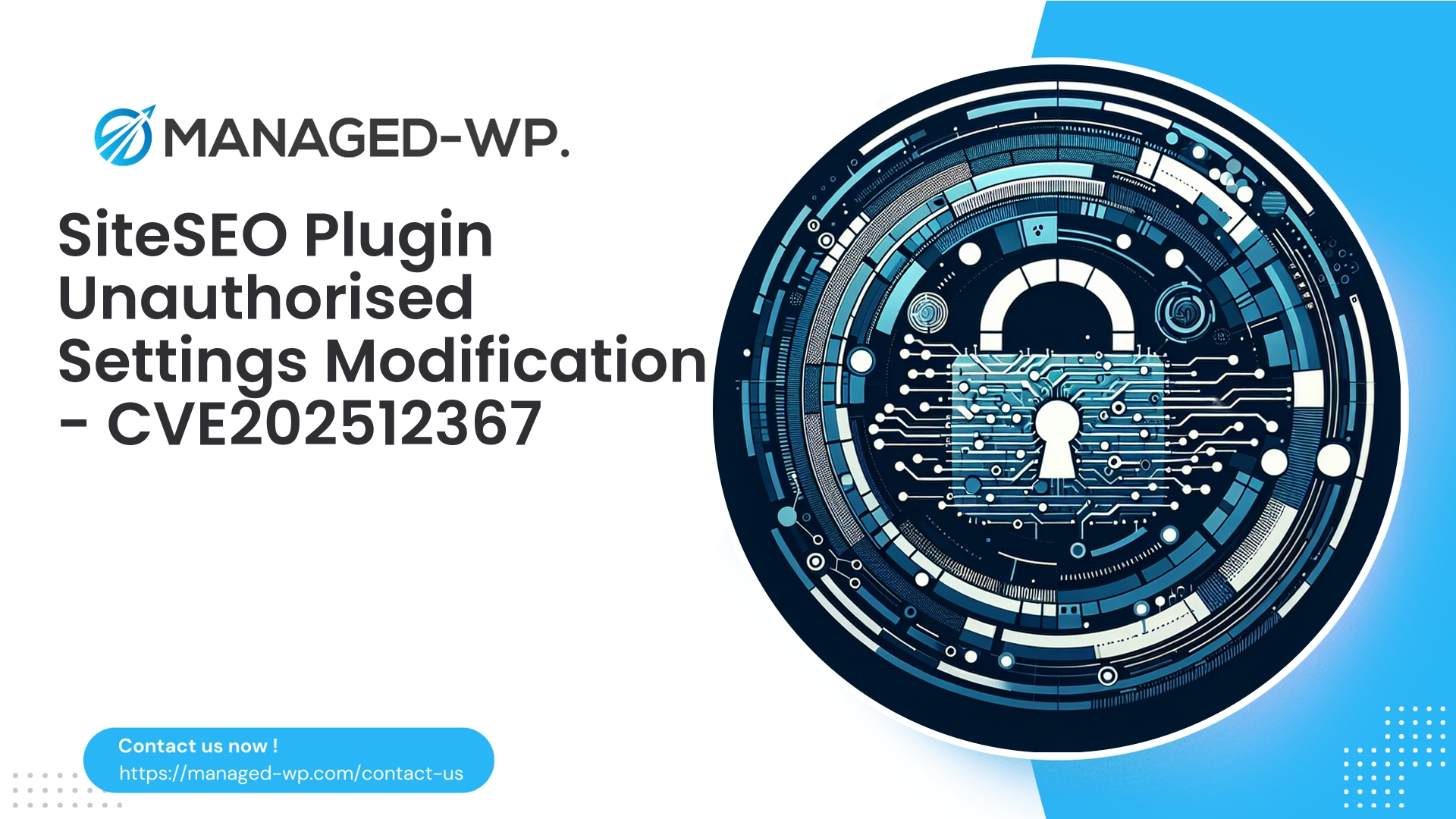| Plugin Name | Post SMTP |
|---|---|
| Type of Vulnerability | Missing Authorization |
| CVE Number | CVE-2025-11833 |
| Urgency | Critical |
| CVE Publish Date | 2025-11-03 |
| Source URL | CVE-2025-11833 |
Post SMTP (<= 3.6.0) — Missing Authorization Allowing Email-Log Exposure and Account Takeover: Critical Steps for WordPress Site Owners
Author: Managed-WP Security Team
Date: 2025-11-03
Tags: WordPress, Security, Vulnerability, Post SMTP, CVE-2025-11833, Incident Response, WAF
Executive Summary: A critical security flaw (CVE-2025-11833) impacting Post SMTP WordPress plugin versions 3.6.0 and earlier allows unauthorized users to access sensitive email log data and potentially perform account takeovers. This vulnerability exposes confidential information such as password reset tokens and SMTP credentials. This article provides a comprehensive, expert-level analysis of the vulnerability, real-world risk scenarios, detection strategies, mitigation steps, WAF rule recommendations, incident response processes, and long-term hardening tactics from the perspective of US-based WordPress security professionals.
Contents
- Vulnerability Overview
- Severity and Security Implications
- Technical Explanation (Non-Exploitative)
- Potential Attack Vectors and Impact
- Urgent Actions (Within 24 Hours)
- Interim Mitigations (24-72 Hours)
- Recommended WAF and Virtual Patching Strategies
- Detection and Forensic Analysis
- Incident Response and Recovery Checklist
- Security Hardening and Policy Recommendations
- Monitoring and Logging Best Practices
- FAQs
- Protect Your Site with Managed-WP
- Conclusion and References
Vulnerability Overview
On November 3, 2025, a critical vulnerability (CVE-2025-11833) was disclosed in the Post SMTP WordPress plugin. This weakness stems from missing authorization checks, allowing unauthenticated actors to access sensitive email log data without proper permissions. Because these logs contain deeply sensitive data such as password reset URLs, verification tokens, SMTP credentials, and other metadata, attackers leveraging this flaw may escalate to full account takeovers—including administrative access.
While an immediate fix (Post SMTP 3.6.1+) is available and strongly recommended, this report extends beyond patch advisories: offering detailed detection, mitigation, incident response, and strategic hardening advice.
Severity and Security Implications
- Unauthenticated Access: No login required, making any visitor or automated bot a potential attacker.
- Exposure of Sensitive Data: Email logs reveal critical information such as password reset tokens, admin email addresses, and SMTP credentials.
- Chained Exploitation: Attackers can leverage exposed data for phishing, credential stuffing, or direct account compromise.
- Mass Attack Risk: High likelihood of widespread automated scanning increases exposure for unpatched sites.
- Critical Severity: CVSS score 9.8 highlights both ease of exploitation and severe impact potential.
Technical Explanation (High-Level, Non-Exploitative)
The vulnerability arises from insufficient authentication and authorization on endpoints within the plugin responsible for serving email logs. Expected security controls include:
- Verifying user authentication.
- Validating that the user has privileges to view SMTP/email logs (typically admin roles).
- Ensuring only sanitized log data is returned to authorized entities.
The flaw allowed any unauthenticated user to access full logs, potentially exposing tokens and credentials enabling further attacks.
Note: This overview avoids exploit specifics to support responsible disclosure and defense.
Potential Attack Vectors and Impact
- Exploitation of Password Reset Links: An attacker may use valid reset tokens found in logs to hijack administrative accounts.
- Admin Email Harvesting: Useful for targeted phishing campaigns or credential stuffing attacks.
- SMTP Credentials Exposure: Leaked credentials may be abused to intercept mail or send spoofed emails.
- Cross-System Compromise: Email/password reuse across systems can allow lateral movement in broader environments.
- Root-Level Site Control: With admin access, attackers can implant backdoors, escalate persistence, or manipulate site content.
This vulnerability places site integrity, data confidentiality, and reputation at immediate risk.
Urgent Actions (Within 24 Hours)
- Update Immediately: The single most critical step is to upgrade Post SMTP to version 3.6.1 or later.
- Restrict Access: If immediate patching is impossible, block access via WAF or server rules to relevant plugin endpoints.
- Credential Rotation:
- Change SMTP and API credentials.
- If password resets may have been intercepted, reset admin passwords promptly.
- Audit Admin Accounts: Look for unauthorized admin users, suspicious theme or plugin changes, and unexpected scheduled tasks.
- Backup Your Site: Make a comprehensive backup (files and database) before remediation.
- Enforce Two-Factor Authentication: Protect admin accounts to prevent takeover even if credentials leak.
Interim Mitigations (24-72 Hours)
If unable to patch immediately, implement these safeguards:
- Temporarily Disable Plugin: Deactivate Post SMTP if non-essential until patched.
- Block Access to Plugin Endpoints: Using web server or WAF controls, deny unauthenticated requests to plugin log URLs, e.g.
/wp-content/plugins/post-smtp/*. - Limit Admin Area Access: Restrict /wp-admin and /wp-login.php to trusted IPs, if possible.
- Enforce Authentication Cookies: Use WAF to block plugin log access lacking valid WordPress auth cookies.
- Audit Password Reset Token Lifespan: Ensure tokens are short-lived and single-use.
- Enhance Monitoring: Increase logging and watch for suspicious activity patterns.
Recommended WAF and Virtual Patching Strategies
Deploy these conceptual WAF rules to virtually patch the vulnerability until official remediation is in place. Always test rules first in log/alert mode to avoid disrupting legitimate traffic.
- Block Unauthenticated Access to Logs:
- Pattern: Deny GET/POST requests matching
^/wp-content/plugins/post-smtp/(.*(log|logs|email|download|export).*)$ - Condition: Requests without valid WordPress authentication cookie (e.g., wordpress_logged_in_*).
- Pattern: Deny GET/POST requests matching
- Deny Plugin-Related admin-ajax Requests Without Auth:
- Block requests to
/wp-admin/admin-ajax.phpwith parameteractioncontainingpost_smtporpst_lacking auth.
- Block requests to
- Require Referrer and Auth Checks for Log Downloads: Flag or block requests to log downloads originating externally without valid auth.
- Rate Limit Suspicious Traffic: Throttle or challenge clients exhibiting repeated requests to plugin endpoints.
- Block Known Malicious Query Parameters: Deny unauthenticated query strings with parameters like
log_id,pst_log_id. - Alert on Suspicious Requests: Log and notify on matching requests that are not blocked to catch reconnaissance attempts.
Note: Conservative implementation and thorough testing on staging environments are crucial before deploying WAF rules in production.
Detection and Forensic Analysis
To investigate possible exploitation or assess exposure, perform the following:
- Web Server Logs: Identify requests to plugin paths, suspicious query strings, or frequent calls from single IPs.
- WordPress Activity Logs: Review recent admin user activity, password resets, role changes, and plugin updates.
- Email Logs: Verify if password resets or administrative email messages were generated and their security state.
- File Integrity: Scan for unexpected files, modifications or injected code in core/theme/plugin files.
- Database Inspection: Check for unknown admin accounts, rogue options/settings, or suspicious cron tasks.
- SMTP Activity: Watch for sudden spikes or abnormal sending patterns indicating credential misuse.
- External Scan Correlation: Cross-reference public scan logs or honeypot data for known reconnaissance activity.
Incident Response and Recovery Checklist
- Containment: Temporarily block suspicious traffic or enable maintenance mode to halt attack progress.
- Evidence Preservation: Create site and database snapshots before making changes.
- Credential Rotation: Reset all admin passwords and rotate API/SMTP keys.
- Cleanup: Remove unauthorized users, malicious files, and unknown cron jobs.
- Patching: Upgrade Post SMTP and all site components to current versions.
- Comprehensive Scanning: Run malware and backdoor detection tools; consider third-party audits.
- Reinstate with Controls: Reactivate services with two-factor authentication and WAF protections enforced.
- Notification: Follow legal requirements to notify affected users if personal data was compromised.
- Post-Incident Review: Conduct root cause analysis and update your security policies accordingly.
Security Hardening and Policy Recommendations
- Principle of Least Privilege: Limit roles and capabilities strictly as needed.
- Regular Plugin Audits: Remove inactive or unmaintained plugins promptly.
- Staging Environment Testing: Validate updates and security checks prior to production deployment.
- Secrets Management: Store SMTP and API credentials securely; practice regular rotation.
- Monitoring and Alerting: Centralize logs, with alerts for account changes and suspicious access attempts.
- Automated Updates: Where possible, enable automated updating or virtual patching for critical components.
- Security Review Processes: Apply authentication and authorization checks systematically during development.
Monitoring and Logging Best Practices
- Maintain comprehensive web server access logs with rotation policies.
- Enable WordPress activity logging for administrative changes.
- Set real-time alerts for new admin accounts and mass password resets.
- Track anomalous request volume targeting plugin endpoints.
- Monitor outgoing SMTP traffic for unusual spikes or failures.
- Use file integrity monitoring solutions to detect unauthorized changes.
- Conduct frequent vulnerability scans on site and plugins.
Effective correlation and alerting through centralized log management or SIEM platforms will facilitate early detection and rapid response.
Frequently Asked Questions
- Q: Is updating to Post SMTP 3.6.1 enough to fully protect my site?
- A: Updating addresses the core authorization flaw. However, verify your settings post-update and rotate relevant credentials to secure against any prior compromise.
- Q: Should I remove Post SMTP completely?
- A: Only if its functionality is not essential. Otherwise, update promptly and ensure logs are not publicly accessible. Consider external email sending services to minimize risk.
- Q: Can WAF rules alone protect my site from this vulnerability?
- A: WAF virtual patches provide essential interim protection but should not replace applying the official plugin patch. WAF coverage may be bypassed in certain scenarios; patching remains critical.
Protect Your Site with Managed-WP
Managed-WP: Enterprise-Grade WordPress Security Tailored for US Businesses
For WordPress site owners serious about security, Managed-WP delivers comprehensive defense beyond what standard hosting offers. Our suite includes:
- Advanced Web Application Firewall (WAF) uniquely tuned for WordPress vulnerabilities
- Automated virtual patching and fine-grained role-based traffic filtering
- Personalized onboarding with a step-by-step security checklist
- Real-time monitoring, incident alerting, and priority remediation support
- Expert best-practice guidance on secrets management and role hardening
Exclusive Offer for Blog Readers: Access our MWPv1r1 protection plan—industry-grade security starting at just USD 20/month.
Protect My Site with Managed-WP MWPv1r1 Plan
Why Choose Managed-WP?
- Immediate coverage against newly discovered plugin and theme vulnerabilities
- Custom WAF rules and instant virtual patching for high-risk scenarios
- Dedicated concierge onboarding, expert remediation, and actionable guidance
Don’t wait for the next breach. Safeguard your WordPress site and brand reputation with Managed-WP — the trusted choice for security-conscious businesses.
Start your protection today with MWPv1r1 at USD 20/month
Closing Notes
The disclosure of CVE-2025-11833 reinforces that missing authorization—even in administrative functions like email logging—can lead to severe breach risks. Immediate action to update Post SMTP is paramount. For environments unable to patch immediately, follow guided mitigations, implement WAF protections, rotate credentials, and conduct thorough forensic analysis.
Managed-WP Security Team strongly recommends layered defenses: prompt patching, robust authentication (including 2FA), continuous monitoring, and managed virtual patching. Contact us if you require assistance applying these recommendations or expert incident response support.
Stay vigilant and secure your WordPress sites proactively.
— Managed-WP Security Team
References and Further Reading
- CVE-2025-11833 Official Record
- Post SMTP Plugin Repository and Change Logs
- WordPress Security Hardening Documentation and Best Practices
Take Proactive Action — Secure Your Site with Managed-WP
Don’t risk your business or reputation due to overlooked plugin flaws or weak permissions. Managed-WP provides robust Web Application Firewall (WAF) protection, tailored vulnerability response, and hands-on remediation for WordPress security that goes far beyond standard hosting services.
Exclusive Offer for Blog Readers: Access our MWPv1r1 protection plan—industry-grade security starting from just USD 20/month.
- Automated virtual patching and advanced role-based traffic filtering
- Personalized onboarding and step-by-step site security checklist
- Real-time monitoring, incident alerts, and priority remediation support
- Actionable best-practice guides for secrets management and role hardening
Get Started Easily — Secure Your Site for USD 20/month:
Protect My Site with Managed-WP MWPv1r1 Plan
Why trust Managed-WP?
- Immediate coverage against newly discovered plugin and theme vulnerabilities
- Custom WAF rules and instant virtual patching for high-risk scenarios
- Concierge onboarding, expert remediation, and best-practice advice whenever you need it
Don’t wait for the next security breach. Safeguard your WordPress site and reputation with Managed-WP—the choice for businesses serious about security.
Click above to start your protection today (MWPv1r1 plan, USD 20/month).


















